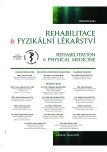Motor Learning Mechanisms and Application in Rehabilitation
Authors:
M. Kodadová; J. Opavský
Published in:
Rehabil. fyz. Lék., 26, 2019, No. 2, pp. 55-60.
Category:
Original Papers
Overview
The article summarizes essential knowledge of motor learning in the context of rehabilitation. The aim was to link together the theoretical fundamentals with the practical issues of motor learning. The theoretical framework includes distinction between types of motor learning, description of its phases and neuroanatomical structures involved. The following part focused on practical issues is comprised of explicit and implicit motor learning approaches, external factors influencing the motor learning effectivity and its assessment tools. At the end of the article several rehabilitation methods based on motor learning principles are introduced.
Keywords:
motor learning – types of motor learning – augmented feedback – factors affecting motor learning
Sources
1. BUCCINO, G., RIGGIO, L.: The role of the mirror neuron system in motor learning. Kinesiology [online], roč. 38, 2006, č. 1, s. 5-15. Dostupné z: https://core.ac.uk/do wnload/pdf/14378383.pdf.
2. CANO-DE-LA-CUERDA, R., MOLERO-SÁNCHEZ, A., CARRATALÁ-
-TEJADA, M., ALGUACIL-DIEGO, I. M., MOLINA‑RUEDA, F., MIANGOLARRA-PAGE, J. C., TORRICELLI, D.: Theories and control models and motor learning: Clinical applications in neurorehabilitation. Neurología, roč. 30, 2015, č. 1, s. 32-41. doi:10.1016/j.nrleng.2011.12.012.
3. CARVALHO, D., TEIXEIRA, S., LUCAS, M., YUAN, T., CHAVES, F., PERESSUTTI, C., MACHADO, S., BITTENCOURT, J., MENÉNDEZ-GONZÁLEZ, M., NARDI, A. E., VELASQUES, B., CAGY, M., PIEDADE, R., RIBEIRO, P., ARIAS-CARRIÓN, O.: The mirror neuron system in post-stroke rehabilitation. International Archives of Medicine [online], roč. 6, 2013, č. 41. Dostupné z: https://intarchmed.biomedcentral.com/articles/10.1186/1755-7682-6-41#Abs1, doi:10.1186/1755-7682-6-41.
4. DOYON, J., BENALI, H.: Reorganization and plasticity in the adult brain during learning of motor skills. Current Opinion in Neurobiology, roč. 15, 2005, č. 2, s. 161-167. doi:10.1016/j.conb.2005.03.004.
5. DRAGOUNOVÁ, Z., PERIČ, T., DOVADIL, J.: Implicitní motorické učení – možnosti ve sportovním tréninku. Česká kinantropologie, roč. 17, 2013, č. 3, s. 11-22. ISSN: 1211-9261.
6. KITAGO, T., KRAKAUER, J. W.: Motor learning principles for neurorehabilitation. In BARNES, M. P., GOOD, D. C. (Eds.) Handbook of clinical neurology. Amsterdam, Elsevier Science Technology, roč. 110, 2013, s. 93-103. ISBN: 978-0-444-52901-5.
7. KRAKAUER, J. W.: Motor learning: its relevance to stroke recovery and neurorehabilitation. Current Opinion in Neurology, roč. 19, 2006, č. 1, s. 84-90. doi:10.1097/01.wco.0000200544.29915.
8. KRAKAUER, J. W.: The applicability of motor learning to neurorehabilitation. In DIETZ, V., WARD, N. (Eds.) Oxford Textbook of Neurorehabilitation. 1st ed. Oxford, Oxford University Press, 2015, s. 55-63. ISBN 978-0-19-967371-1.
9. LAGO-RODRÍGUEZ, A., CHEERAN, B., KOCH, G., HORTOBÁGYI, T., FERNANDEZ-DEL-OLMO, M.: The role of mirror neurons in observational motor learning: an integrative review. European Journal of Human Movement, roč. 32, 2014, s. 82-103. doi:10.3389/fnhum.2013.00396.
10. LEVIN, M. F., WEISS, P. L., KESHNER, E. A.: Emergence of virtual reality as a tool for upper limb rehabilitation: incorporation of motor control and motor learning principles. Physical Therapy, roč. 95, 2015, č. 3, s. 415-425. doi:10.2522/ptj.20130579.
11. MAGILL, R., ANDERSON, D.: Motor learning and control. Concepts and applications. Singapore, McGraw-Hill Education, 2014, s. 257, 274-276. ISBN 978-1-259-01076-7.
12. MASAKI, H., SOMMER, W.: Cognitive neuroscience of motor learning and motor control. The Journal of Sports Medicine and Physical Fitness, roč. 1, 2012, č. 3, s. 369-380. doi:10.7600/jpfsm.1.369.
13. MASTERS, R. S. W., MAXWELL, J. P.: Implicit motor learning, reinvestment and movement disruption: what you don’t know won’t hurt you? In WILLIAMS, A. M., HODGES, N. J. (Eds.) Skill acquisition in sport: Research, theory and practice. London, Routledge, 2004, s. 207-228. ISBN 0-415-27075-8.
14. SCHMIDT, R. A., LEE, T. D.: Motor control and learning: a behavioral emphasis. [5th ed.]. Champaign, IL, Human Kinetics, 2011, s. 352-371. ISBN: 0-7360-7961-0.
15. SEIDLER, R. D.: Neural correlates of motor learning, transfer of learning, and learning to learn. Exercise and Sport Sciences Reviews, roč. 38, 2010, č. 1, s. 3-9. doi:10.1097/jes.0b013e3181c5cce7.
16. SHADMEHR, R., KRAKAUER, J. W.: A computational neuroanatomy for motor control. Experimental Brain Research, roč. 185, 2008, č. 3, s. 359-381. doi:10.1007/s00221-008-1280-5.
17. SHEA, J. B., MORGAN, R. L.: Contextual interference effects on the acquisition, retention, and transfer of a motor skill. Journal of Experimental Psychology: Human Learning and Memory, roč. 5, 1979, č. 2, s. 179-187. doi:10.1037/0278-7393.5.2.179.
18. SHMUELOF, L., KRAKAUER, J. W.: Are we ready for a natural history of motor learning? Neuron, roč. 72, 2011, č. 3, s. 469-476. doi:10.1016/j.neuron.2011.10.017.
19. STEENBERGER, B., VAN DER KAMP, J., VERNEAU, M., JONGBLOED-PEREBOOM, M., MASTERS, R. S. W.: Implicit and explicit learning: applications from basic research to sports for individuals with impaired movement dynamics. Disability and Rehabilitation, roč. 32, 2010, č. 18, s. 1509-1516. doi:10.3109/09638288.2010.497035.
20. STERR, A., ELBERT, T., BERTHOLD, I., KÖLBEL, S., ROCKSTROH, B., TAUB, E.: Longer versus shorter daily constraint-induced movement therapy of chronic hemiparesis: an exploratory study. Archives of Physical Medicine and Rehabilitation, roč. 83, 2002, č. 10, s. 137-1377. doi:10.1053/apmr.2002.35108.
Labels
Physiotherapist, university degree Rehabilitation Sports medicineArticle was published in
Rehabilitation & Physical Medicine

2019 Issue 2
Most read in this issue
- Recommended Procedure for the Examination of Infants and Toddlers in the Child Ohysiotherapist Office from the View of Developmental Kineziology and Reflex Locomotion by Vojta
- Motor Learning Mechanisms and Application in Rehabilitation
- Must a Chronic Pain always Continue
- The Impact of Weather on Pain and Physical Activity of Osteoarthrosis Patiens
